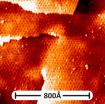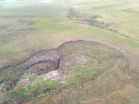(Press-News.org) ALBUQUERQUE, N.M. — Sandia National Laboratories' one-of-a-kind multiphase shock tube began with a hallway conversation that led to what engineer Justin Wagner describes as the only shock tube in the world that can look at how shock waves interact with dense particle fields.
The machine is considered multiphase because it can study shock wave propagation through a mixture of gas and solid particles.
Shock tubes — machines that generate shock waves without an explosion — have been around for decades. What makes Sandia's unique is its ability to study how densely clustered particles disperse during an explosion. That's important because better understanding of the physics during the first tens of microseconds of a blast leads to better computer models of what happens in explosions.
"Not having this correct in those codes could have implications for predicting different explosives properties," Wagner said.
Understanding how particles move and react in the early part of a blast will help Sandia respond to such national security challenges as improving explosives, mitigating blasts or assessing the vulnerability of personnel, weapons and structures.
The project started when Steve Beresh of Sandia's aerosciences department and Sean Kearney of the Labs' thermal and fluid experimental sciences asked a since-retired colleague what he'd like to measure that he hadn't been able to. He started talking about some of the physics missing from the models used for predicting explosives, "and Sean and I looked at each other and said, 'We think we could do that,'" Beresh said.
They came up with the idea of a multiphase shock tube that would enable researchers to study particle dispersal in dense gas-solid flows.
The machine was fired for the first time in April 2010. Experiments and diagnostics are complicated, so team members are still gathering data they eventually will incorporate into codes used at Sandia and elsewhere.
"It's clear that we've learned some things that weren't known before," Beresh said. "Those physics are important to a code."
The stainless steel and aluminum shock tube, about 22 feet long, is divided into a high-pressure or driver section that creates the shock wave and a low-pressure or driven section, with a diaphragm between the two. Pressure builds up in the cylindrical driver section and when it gets high enough, the diaphragm ruptures. Spherical particles loaded into a hopper above the low-pressure section flow into the shock tube before the diaphragm breaks, creating a dense particle curtain that's hit by the shock wave.
The project, initially funded under Sandia's Laboratory Directed Research and Development program, hired Wagner to oversee the machine's design and building. "When we hired Justin we had an empty room and a blank sheet of paper. Now we have a shock tube that is different from what anybody else in the world has," Beresh said.
Particles in an explosion start out tightly packed. As the explosive process continues, they disperse and quickly become widely spaced. But the physics of the densely packed particles at the start of the explosion are crucial to everything that comes later. They are not yet fully understood, and thus limit current models, Wagner and Beresh said.
"The important thing about the shock tube is it generates a planar shock wave," Wagner said. "We study the interaction of the shock wave with a dense field of particles to understand the physics relevant to explosives processes."
Sandia's machine uses such diagnostics as high-speed pressure measurements, high-speed imaging and flash X-ray to measure gas and particle properties, and it's adding laser-based diagnostics, team members said.
"We can get different things from the X-ray diagnostics, different things from the laser-based diagnostics, different things from temperature and pressure measurements, and by piecing all of that together we get a better view of the physics that are occurring in the shot," Beresh said.
The machine's unique diagnostic capabilities demonstrate Sandia's ability to collaborate. The team particularly singled out the X-ray expertise offered by Enrico Quintana and Jerry Stoker's group in the experimental mechanics/non-destructive evaluation & model validation organization. Elton Wright of geothermal research also made sizeable contributions.
The diagnostics required to get useful information from the machine are difficult and expensive, Wagner said. "There's a reason why it hasn't been done thoroughly in the past," he said.
A lot of data for modeling comes from explosions, but it's difficult to isolate what happens in each part of a blast, Kearney said. "Whereas if you do an experiment like this you can delve deeper into what is really happening," he said. "But it's just one piece of the puzzle and they're all important."
###
Sandia National Laboratories is a multi-program laboratory operated by Sandia Corporation, a wholly owned subsidiary of Lockheed Martin company, for the U.S. Department of Energy's National Nuclear Security Administration. With main facilities in Albuquerque, N.M., and Livermore, Calif., Sandia has major R&D responsibilities in national security, energy and environmental technologies and economic competitiveness.
Sandia news media contact: Sue Holmes, sholmes@sandia.gov, (505) 844-6362
Researchers use shock tube for insight into physics early in blasts
2012-11-27
ELSE PRESS RELEASES FROM THIS DATE:
Brief exercise immediately enhances memory, UCI study finds
2012-11-27
Irvine, Calif., Nov. 26, 2012 — A short burst of moderate exercise enhances the consolidation of memories in both healthy older adults and those with mild cognitive impairment, scientists with UC Irvine's Center for the Neurobiology of Learning & Memory have discovered.
Most research has focused on the benefits of a long-term exercise program on overall health and cognitive function with age. But the UCI work is the first to examine the immediate effects of a brief bout of exercise on memory.
In their study, UCI postdoctoral scholar Sabrina Segal and neurobiologists ...
New behavioral strategies may help patients learn to better control chronic diseases
2012-11-27
One of the most important health problems in the United States is the failure of patients with chronic diseases to take their medications and do all that is necessary to control their illnesses.
In a study published online in the Journal of General Internal Medicine, UCLA researchers and their colleagues suggest that physicians take a serious look at tools and strategies used in behavioral economics and social psychology to help motivate their patients to assert better control over chronic diseases. Breaking large goals into smaller, more manageable parts, for example, ...
USC, Oxford researchers find high fructose corn syrup-global prevalence of diabetes link
2012-11-27
LOS ANGELES AND OXFORD, U.K.— A new study by University of Southern California (USC) and University of Oxford researchers indicates that large amounts of high fructose corn syrup (HFCS) found in national food supplies across the world may be one explanation for the rising global epidemic of type 2 diabetes and resulting higher health care costs.
The study reports that countries that use HFCS in their food supply had a 20 percent higher prevalence of diabetes than countries that did not use HFCS. The analysis also revealed that HFCS's association with the "significantly ...
Administrative data set not always best source for number of surgical complications
2012-11-27
Charlottesville, VA (November 27, 2012). Hospital administrative databases, designed to provide general information on hospital stays and associated costs, are frequently used to find information that can lead to quality assessments of care or clinical research. Researchers at the University of California, San Francisco (UCSF) extracted data on hospital readmissions following spine surgery at their institution from an administrative database to assess the clinical relevance of the information and to define clinically relevant predictors of readmission. What they found were ...
Graphene switches: HZB research group makes it to first base
2012-11-27
Now, Helmholtz Centre Berlin's Dr. Andrei Varykhalov, Prof. Dr. Oliver Rader and his team of physicists has taken the first step towards building graphene-based components, in collaboration with physicists from St. Petersburg (Russia), Jülich (Germany) and Harvard (USA). According to their report on 27. November 2012 in Nature Communications (DOI: 10.1038/ncomms2227), they successfully managed to increase the graphene conduction electrons' spin-orbit coupling by a factor of 10,000 – enough to allow them to construct a switch that can be controlled via small electric fields.
The ...
Protein injection points to muscular dystrophy treatment
2012-11-27
November 27, 2012 — Ottawa — Scientists have discovered that injecting a novel human protein into muscle affected by Duchenne muscular dystrophy significantly increases its size and strength, findings that could lead to a therapy akin to the use of insulin by diabetics. These results were published today in the Proceedings of the National Academy of Sciences by Dr. Julia von Maltzahn and Dr. Michael Rudnicki, the Ottawa scientist who discovered muscle stem cells in adults.
"This is an unprecedented and dramatic restoration in muscle strength," says Dr. Rudnicki, a senior ...
Study finds heavily indebted med students choosing primary care face greater financial challenges
2012-11-27
(Boston) - Researchers at Boston University and the Association of American Medical Colleges (AAMC) have determined that heavily indebted medical students choosing primary care careers will experience difficulty paying their student debt unless they consider alternative strategies to support repayment. These findings appear online in Academic Medicine, the peer-reviewed Journal of the AAMC.
Most medical school graduates have education debt and the average amount of education debt is increasing. In 2011, 86 percent had education debt at graduation, averaging $161,290, ...
James' bond: A graphene/nanotube hybrid
2012-11-27
HOUSTON – (Nov. 27, 2012) – A seamless graphene/nanotube hybrid created at Rice University may be the best electrode interface material possible for many energy storage and electronics applications.
Led by Rice chemist James Tour, researchers have successfully grown forests of carbon nanotubes that rise quickly from sheets of graphene to astounding lengths of up to 120 microns, according to a paper published today by Nature Communications. A house on an average plot with the same aspect ratio would rise into space.
That translates into a massive amount of surface area, ...
GI researcher co-author of international permafrost report
2012-11-27
Fairbanks, Alaska—University of Alaska Fairbanks researcher Vladimir Romanovsky is one of four scientists who authored a report released today by the United Nations Environmental Programme.
The report, "Policy Implications of Warming Permafrost," seeks to highlight the potential hazards of carbon dioxide and methane emissions from warming permafrost, which have not thus far been included in climate-prediction modeling. The report notes that permafrost covers almost a quarter of the northern hemisphere and contains 1,700 gigatonnes of carbon—twice that currently in the ...
How devout are we? Study shows evangelicals surge as Catholics wane
2012-11-27
The percentage of Americans who say they are strong in their religious faith has been steady for the last four decades, a new study finds. But in that same time, the intensity of some religious groups has surged while others – notably Roman Catholics – has faded.
Among the risers: Evangelicals, who have become more staunchly devout since the early 1990s. Meanwhile, Catholics now report the lowest proportion of strongly affiliated followers among major American religious traditions.
The drop in intensity could present challenges for the Roman Catholic Church, the study ...


